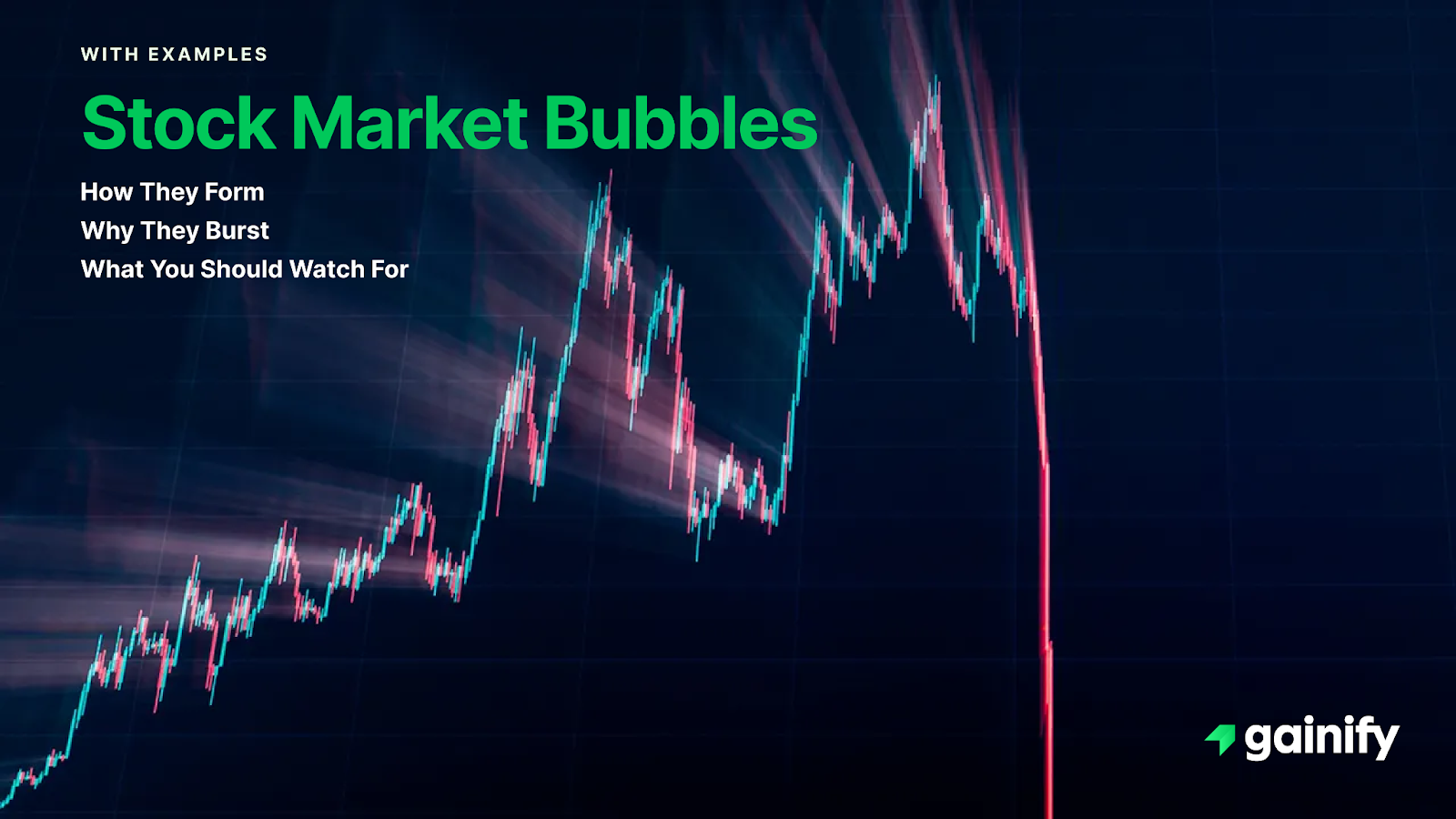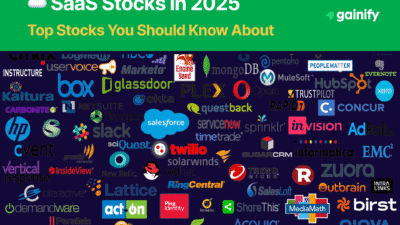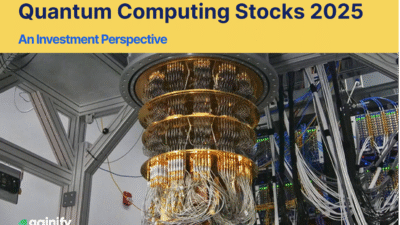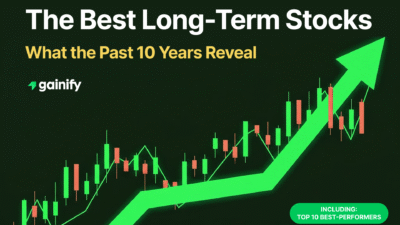You’ve probably heard the phrase “stock market bubble” used a lot, especially when the market is hitting new highs and valuations start to look stretched. But what exactly is a stock market bubble?
Why do they form in the first place?
And how can you tell when you’re in one before it bursts?
These questions are more relevant than ever. The rapid rise of artificial intelligence, growing investor enthusiasm, and sky-high valuations in parts of the financial markets have made even the most experienced professionals pause. Understanding what drives a financial bubble, how it forms, and how it ends is essential for avoiding costly mistakes. It can also help investors stay grounded and spot opportunities that others might overlook.
Let’s take a clear and thorough look at what financial bubbles are, where we’ve seen them before, and the signals to watch for in today’s market environment.
What Is a Financial Bubble?
A financial bubble happens when the price of an asset or an entire asset class like stocks, real estate, or crypto rises far beyond what its underlying fundamentals can justify. These inflated prices are often driven by emotion, herd behavior, easy credit, or a compelling story that convinces investors that this time is different.
Bubbles can form across many sectors. There are stock bubbles, real estate bubbles, commodity bubbles, credit bubbles, and even bubbles within individual asset classes. No matter the setting, the key feature is a major disconnect between market prices and actual value.
As more people join the trend, hoping to ride the momentum, these bubbles tend to grow. But eventually, something cracks. Earnings miss expectations, interest rates go up, or investor sentiment changes. Whatever the reason, when the bubble bursts, it usually does so quickly and painfully.
How Do Bubbles Form?
Bubbles tend to follow a recognizable pattern. They build over time and are often tied to the typical credit cycle or broader economic cycles. Here is how they usually progress:
1. A Triggering Event
Often, there is a breakthrough or a major economic shift that sparks excitement. This could be something like the rise of the internet in the 1990s or today’s rapid advances in artificial intelligence. This leads to increased investor interest and rising stock prices.
2. Strong Performance and Growing Optimism
Early gains attract more money. The media takes notice, and investment funds start flowing into related areas. The narrative becomes so strong that even cautious investors begin to join in.
3. Speculative Frenzy
Momentum takes over. Valuations rise well beyond normal levels. Companies go public without solid business models. Fundamentals are ignored, and hopes for the future take center stage.
4. Market Peaks
Asset values reach all-time highs. Confidence is sky-high. Investors convince themselves that the old rules no longer apply.
5. Reality Sets In
Growth slows, earnings disappoint, or interest rates rise. Risk appetite disappears almost overnight.
6. Collapse
The sell-off begins. Panic spreads. What once looked like a smart investment quickly becomes a painful lesson.
Famous Bubbles That Changed Everything
Looking at historical bubbles helps us recognize familiar warning signs. Here are a few of the most well-known cases:
Tulip Mania (1630s)
Often cited as the first documented speculative bubble, Tulip Mania occurred during the Dutch Golden Age. Tulips, newly introduced to Europe from the Ottoman Empire, became a luxury item and status symbol. As demand grew, prices soared, especially for rare varieties. At the height of the mania, a single bulb of the highly prized Semper Augustus was reportedly sold for the equivalent of a skilled worker’s annual salary or even the cost of a canal house in Amsterdam. Futures contracts for tulips were traded, creating a speculative frenzy disconnected from the bulb’s intrinsic value. By early 1637, the market abruptly collapsed when buyers failed to show up at auctions. Prices plummeted, leaving investors holding contracts for bulbs worth a fraction of what they had paid. While the overall economic damage to the Dutch economy was limited, it served as an early case study of how irrational investor behavior and speculation can inflate asset prices well beyond their fundamentals.
The South Sea Bubble (1720)
This British financial crisis was centered on the South Sea Company, which had been granted a monopoly to trade with South America, then under Spanish control. In practice, very little trade occurred. However, the company was involved in a government debt restructuring scheme, offering to take over Britain’s national debt in exchange for company stock. Backed by political elites and buoyed by speculative fervor, the company’s share price rose nearly tenfold in less than a year. Investors, including aristocrats, bankers, and Members of Parliament, poured in. Insider trading, misleading statements, and outright fraud were rampant. When confidence eventually faltered, shares collapsed, wiping out fortunes. The aftermath led to a financial reckoning: several senior officials were dismissed, and reforms were introduced, including a temporary ban on the formation of new joint-stock companies. The South Sea Bubble remains a defining example of how political entanglement and unchecked optimism can combine to fuel a financial collapse.
The Dotcom Bubble (Late 1990s to Early 2000s)
Fueled by excitement over the Internet’s potential, this speculative bubble saw investors pour money into tech startups with unproven business models and minimal revenues. Companies rushed to go public, and many were valued based on “eyeballs” or website traffic rather than earnings or profits. The NASDAQ Composite Index rose fivefold between 1995 and March 2000. By early 2000, signs of trouble emerged. High-profile failures like Pets.com and eToys, combined with deteriorating earnings and tightening monetary policy by the Federal Reserve, triggered a sharp selloff. By October 2002, the NASDAQ had lost nearly 80% of its value, erasing trillions of dollars in market capitalization. The crash led to layoffs, bankruptcies, and a prolonged bear market in technology stocks, but also paved the way for survivors like Amazon and Google to rise in the years that followed.
The Housing Bubble and the 2008 Global Financial Crisis
The 2000s saw a dramatic rise in U.S. housing prices, driven by low interest rates, aggressive mortgage lending practices, and widespread financial innovation in mortgage-backed securities (MBS). Lenders issued subprime mortgages to borrowers with poor credit, often with little to no documentation or down payment. These risky loans were bundled, securitized, and sold to global investors, including major banks and pension funds. The belief that housing prices would continue rising underpinned these transactions. When home prices peaked in 2006 and began to fall, defaults surged. The collapse of the MBS market triggered massive losses across the financial sector. Iconic institutions like Lehman Brothers failed, and government bailouts were required to stabilize the system. The crisis led to the Great Recession, with over 8 million jobs lost in the U.S., millions of foreclosures, and a prolonged global economic downturn. In response, regulatory frameworks like the Dodd-Frank Act were introduced to improve oversight and transparency in the financial system.
What Are the Warning Signs?
To assess whether the financial markets are entering bubble territory, investors should watch for a combination of valuation metrics, behavioral trends, and macroeconomic disconnects. Here are several key indicators commonly observed during the formation of asset bubbles:
- Extreme Valuations: Price-to-earnings (P/E) and price-to-sales (P/S) ratios significantly above historical norms are one of the clearest signals. When valuations rise faster than the underlying earnings or revenues, it suggests prices may be driven more by speculation than fundamentals.
- Widespread Retail Participation: A sharp increase in retail investor activity, especially driven by social media platforms or trading apps, can point to growing speculative behavior. When inexperienced investors dominate trading volume, market corrections tend to be more abrupt.
- Surge in IPOs and Speculative Listings: A rise in the number of initial public offerings, especially from unprofitable or concept-stage companies, often reflects market exuberance. These IPOs are frequently accompanied by strong short-term gains followed by sharp declines.
- Overly Optimistic Media Narratives: When headlines begin to tout “once-in-a-lifetime opportunities” and portray certain sectors as infallible, caution is warranted. Overconfidence in growth potential without critical analysis usually precedes a reversal.
- Disconnect from Earnings and Cash Flow: If market prices keep rising while earnings estimates stagnate or fall, the detachment from financial performance may indicate that the market is pricing in unrealistic growth assumptions.
- Sharp Short-Term Price Gains: Rapid appreciation in asset values over a short period without major changes in economic fundamentals is often driven by momentum rather than informed investing. This dynamic can be fragile and easily reversed.
What Happens When a Bubble Bursts?
The collapse of a financial bubble can be swift and painful. As asset values begin to decline, investor confidence typically evaporates. In extreme cases, the resulting market dislocation can affect not just portfolios, but also the broader economy.
- Rapid Losses in Market Value: Stocks or sectors that led the bubble often experience sharp declines. Price corrections can reach 50 percent or more in a matter of weeks or months.
- Panic Selling and Volatility: When sentiment turns, liquidity dries up. Selling begets more selling as investors rush to preserve capital. Volatility spikes and market stability deteriorates.
- Institutional Losses: Investment funds, particularly those overexposed to bubble assets, may suffer large drawdowns. Some hedge funds or ETFs may close entirely if redemption pressures mount.
- Macroeconomic Consequences: In severe instances, as seen in 2008, the ripple effects can extend to credit markets, employment, and consumer spending. A sharp drop in asset values weakens balance sheets and reduces economic activity.
- Regulatory Response and Policy Shifts: Policymakers often react to a bursting bubble with monetary easing, new regulations, or fiscal interventions. However, the lag between collapse and response can prolong recovery.
Even smaller-scale corrections, such as the recent decline in high-growth tech stocks, cryptocurrencies, or SPACs, serve as reminders of how quickly sentiment can reverse. Recognizing the warning signs early is crucial for risk management and long-term capital preservation.
Are We in a Bubble Today?
The question of whether we are currently in a stock market bubble is more complicated than it may seem. Views differ widely among economists, investors, and financial strategists. The answer depends not only on how you define a bubble, but also on which part of the market you are looking at.
Warning Signs Are Present
Some segments of today’s financial markets continue to exhibit characteristics often associated with speculative bubbles. High-growth technology stocks, especially those tied to artificial intelligence, have seen rapid price appreciation. In several sectors, valuation multiples have expanded well beyond long-term averages, even as earnings expectations remain relatively modest. Retail investor participation remains strong, supported by zero-commission trading platforms and widespread access to financial content through social media. In many cases, market prices appear increasingly disconnected from underlying fundamentals such as cash flow, profitability, or balance sheet quality.
Monetary policy has played a key role in shaping this environment. After keeping interest rates near zero for years following the COVID-19 pandemic, the Federal Reserve began aggressively raising rates in 2022 to combat inflation. As of now, rates remain at elevated levels, but market expectations have shifted toward eventual rate cuts in the near term due to signs of slowing inflation and softening growth. This policy pivot has supported risk assets again, leading some investors to question whether renewed enthusiasm is warranted by economic conditions or driven by speculative momentum.
Despite higher interest rates, equity markets have remained resilient. Bond yields, while higher than during the ultra-low era, have not fully cooled investor appetite for growth stocks. Liquidity remains abundant in parts of the market, and capital continues to flow into riskier assets, including cryptocurrencies and emerging technologies.
At the same time, significant geopolitical and macroeconomic risks persist. The ongoing war in Ukraine continues to disrupt global supply chains and energy markets. U.S.-China relations remain tense, with trade disputes, export controls, and technology decoupling creating uncertainty for multinational corporations. New rounds of tariffs and industrial policy initiatives on both sides have added further complexity. While these risks have been acknowledged, they are not always fully reflected in asset prices, especially in sectors benefiting from strong narratives and momentum.
This divergence between price behavior and broader risk factors has prompted some analysts to warn that parts of the market may be entering a new phase of irrational exuberance, despite tighter monetary conditions and a more uncertain global backdrop.
The Case for Rational Valuation
On the other side of the argument, many market participants believe that valuations today reflect real and sustainable growth potential. Unlike the dotcom bubble of the late 1990s, today’s tech giants have strong earnings, high margins, and healthy balance sheets. Companies in artificial intelligence, semiconductors, and enterprise software are showing revenue growth, global demand, and actual profitability. In this context, elevated valuations may be justified by long-term earnings power and innovation-driven expansion.
It is also important to note that today’s market is far more segmented than in past bubbles. Not all asset classes are stretched. While parts of the tech sector may be overvalued, others such as financials, energy, healthcare, and international equities are trading at more reasonable multiples. This variation suggests that markets are not uniformly irrational, which is often the hallmark of a true bubble.
Furthermore, some of the most speculative pockets of the market have already corrected. Stocks tied to pandemic-related trends, special purpose acquisition companies (SPACs), and unprofitable tech firms have declined significantly from their peaks. This kind of selective repricing reflects a healthier market dynamic rather than one caught in a full-blown speculative mania.
A Divided Market, Not a Detached One
The current environment is a mix of legitimate growth optimism and selective over-exuberance. While some stocks appear to be in bubble territory, many others are supported by solid fundamentals. Geopolitical uncertainty, inflation dynamics, interest rate expectations, and shifts in global trade policy add further layers of complexity.
For investors, this means staying vigilant. It is essential to monitor valuations, earnings trends, and risk-adjusted returns. Diversification, discipline, and a focus on long-term fundamentals are the best tools for navigating uncertain markets.
Whether we are in a bubble or not may only become clear in hindsight. But being thoughtful about where risks lie today can help investors avoid the worst outcomes tomorrow.
How to Protect Yourself from Financial Bubbles
Here are some practical steps investors can take:
- Focus on Fundamentals – Make sure the company or asset you are investing in has sustainable earnings, manageable debt, and realistic valuations.
- Diversify Across Asset Classes – Don’t put everything into one basket. Spread risk by including different asset classes like bonds, real estate, and international stocks.
- Avoid Chasing Hype – Just because something is popular doesn’t mean it’s a good investment. Rely on data and analysis, not headlines.
- Know Your Risk Tolerance – If market volatility keeps you up at night, you may be taking on too much risk. Align your portfolio with your financial goals and emotional comfort.
- Think Long Term – Trying to time market tops or bottoms is difficult, even for professionals. Staying disciplined and focused on long-term growth is a more reliable strategy.
Final Thoughts
Financial bubbles have marked some of the most dramatic moments in market history. From tulip mania in the 1600s to the dotcom crash, and more recently to speculative surges in artificial intelligence, cryptocurrencies, and assets boosted by prolonged low interest rates, the underlying pattern remains the same. Prices become detached from fundamentals, optimism turns into euphoria, and eventually, reality forces a reset.
These cycles are driven not just by data or valuations, but by human behavior. Greed, the fear of missing out, and the belief that the old rules no longer apply often outweigh rational analysis. Bubbles typically emerge when easy credit, powerful narratives, and favorable economic conditions converge. When that mix begins to shift, the correction can be fast and painful.
This is why discipline and awareness are essential. Investors should understand the assets they own, monitor valuations closely, and consider the broader context, including monetary policy, earnings trends, and geopolitical risks. A diversified portfolio that focuses on long-term fundamentals tends to weather volatility far better than one chasing short-term momentum.
Not every bull run is a bubble, and not every market pullback is a crisis. Still, in a financial environment where sentiment can shift quickly and risk often builds quietly, staying informed and grounded is critical.
Avoiding the worst outcomes is less about predicting the exact top and more about recognizing when prices no longer reflect reality. When things stop adding up, it’s time to ask the harder questions.




